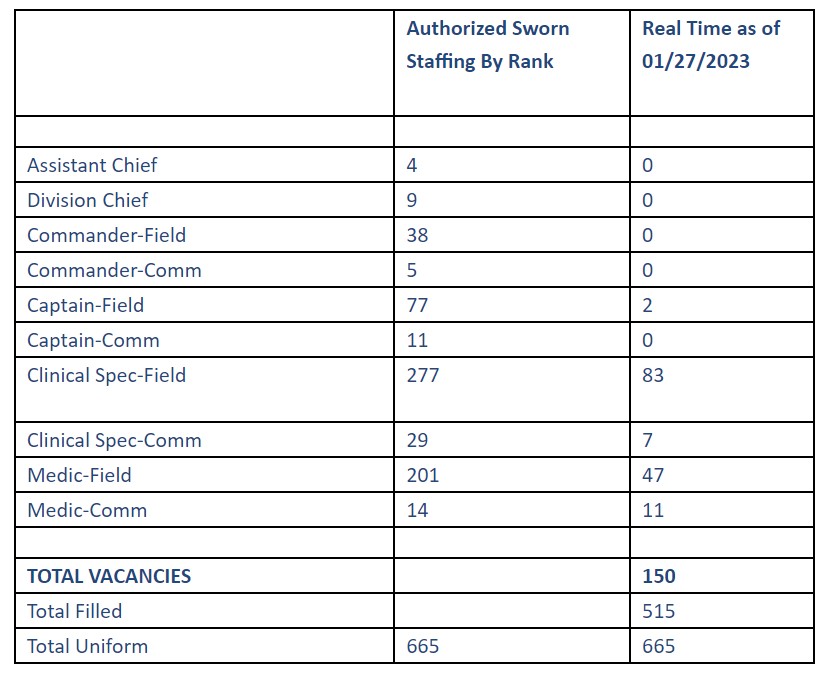City to start major push to recruit employees
Tuesday, January 31, 2023 by
Jo Clifton The city of Austin announced Monday that it would begin a major campaign this week to promote difficult-to-fill jobs. Worker shortages have been particularly noticeable within Austin-Travis County EMS and the police department.
According to information provided by Deborah Jennings in the Human Resources Department, the city currently has 16,316 employees, compared to 16,352 in January 2020 – an overall loss of 36 employees. That number does not reflect the problems created by vacancies in some departments as compared to others or the drop in employees the city suffered in 2021.
The city news release touts the citywide hiring campaign, led by Human Resources and the communications office, as the “largest in the city’s history.” It will run for six months starting Feb. 1 and will include “print, digital, social media, radio, billboards, buses and more to ensure broad reach and recognition.”
According to the release, in September the city “increased starting pay for EMTs and paramedics” and “decreased the minimum entry level qualifications for its cadet-field positions.” The city also increased its cadet academies from two or three per year to four per year, which “has helped reduce vacancies by at least 60 positions since October 2022, with 70-80 additional hires expected by December 2023.”

Current EMS vacancies, city of Austin.
Selena Xie, president of the EMS employees union, told the Austin Monitor that is still not enough. Xie said via text message that the situation has gotten worse, not better. “We only got nine paramedics in the lateral hire class. We could have probably taken up to 30.”
She provided a chart showing that, out of 665 authorized personnel, there are 150 vacancies among sworn staff, 47 vacancies within the EMT field medic position and 201 currently working.
Capt. Darren Noak in the communications division of EMS confirmed the numbers. He noted that a new class had just started Monday with 33 cadets. He said nine of those are lateral transfers, which means they will be ready to work sooner than those who have no previous training or work in the field. He said the number of clinical specialist vacancies has dropped to 83 from 101 a month ago.
The city reported that between Sept. 25, 2022, and Jan. 14, 2023, citywide vacancy numbers fell by 7 percent, from 2,755 to 2,554, with the vacancy numbers for sworn public safety employees falling by 8 percent over the same period.
“While we’ve made progress in filling positions in recent months, we know there’s more work to do,” City Manager Spencer Cronk said. “With departments intensifying their efforts to fill vacancies and our new citywide hiring campaign ready to launch, we’ll continue to do everything we can to recruit and retain talented people to deliver the services our community expects.”
The news release pointed out that Austin had invested heavily in its workforce during last summer’s budget process, by including “an across-the-board pay increase of 4 percent for civilian staff – the largest increase in more than two decades – along with a 33 percent increase in the minimum wage.” City Council pushed hard for the minimum wage of $20 per hour.
According to the city, the increased salaries that began in October “have already led to a higher volume of applications, and more hires, across many departments. However, the city is launching the new jobs campaign in recognition of the likelihood that vacancy rates will remain a challenge for the rest of the year.”
The higher wages for new employees have not been universally popular, as some longtime city workers see new employees making nearly as much as they are, due to compression.
While Carol Guthrie, executive director of AFSCME Local 1624, the union representing city, state and county employees, agreed that the city needs a strong recruitment program, “at the same time I think the city of Austin is losing some very valuable historic perspective that we will never get back because we’re not doing anything to keep the long-term employees that are critical” to the city’s operation, Guthrie said.
While some departments may have good retention plans, Guthrie said, it’s not clear what they are and what the city as a whole is doing to hang on to longtime employees with historical knowledge about how to get things done in the city.
The Austin Monitor’s work is made possible by donations from the community. Though our reporting covers donors from time to time, we are careful to keep business and editorial efforts separate while maintaining transparency. A complete list of donors is available here, and our code of ethics is explained here.
You're a community leader
And we’re honored you look to us for serious, in-depth news. You know a strong community needs local and dedicated watchdog reporting. We’re here for you and that won’t change. Now will you take the powerful next step and support our nonprofit news organization?










